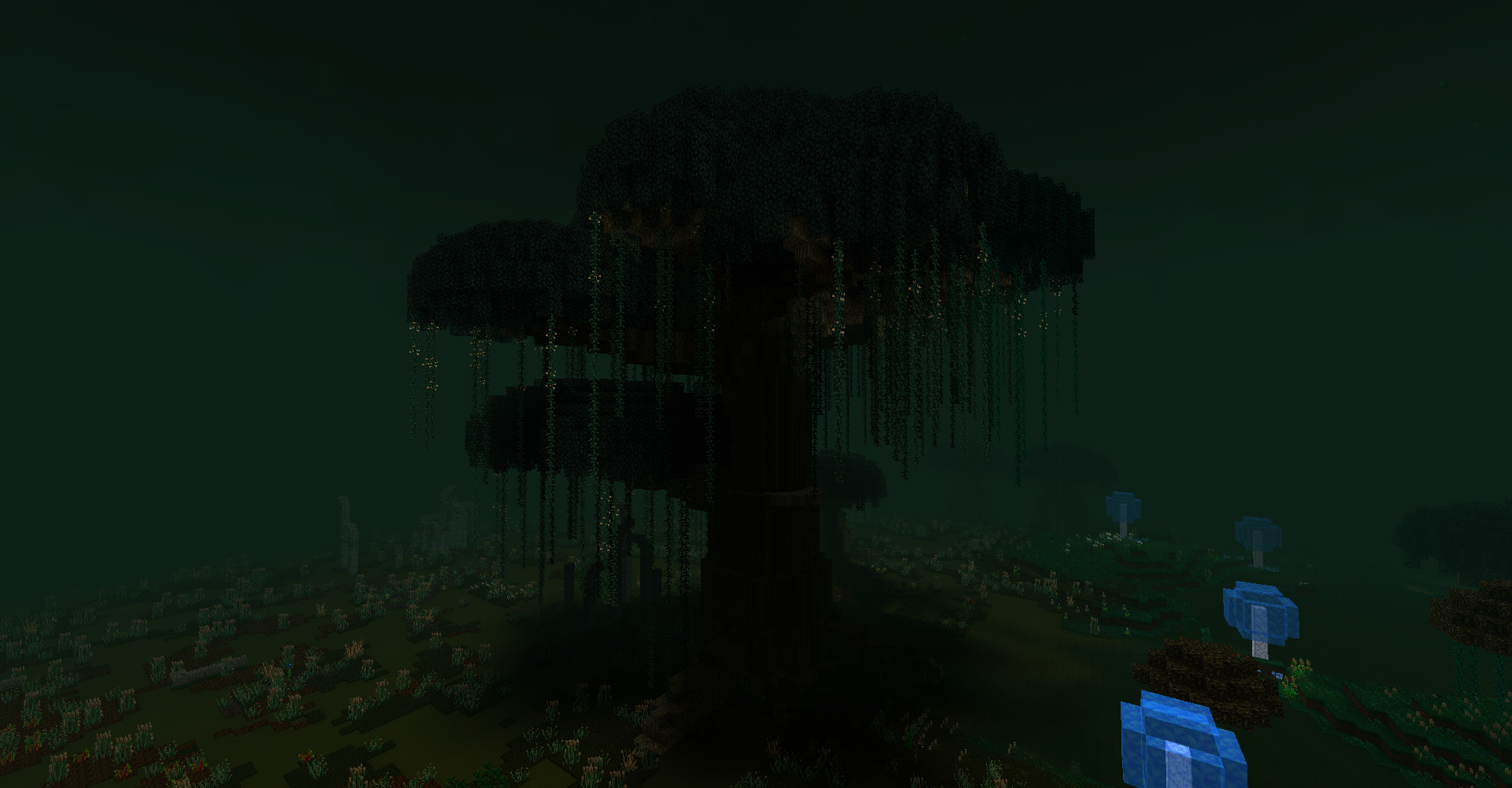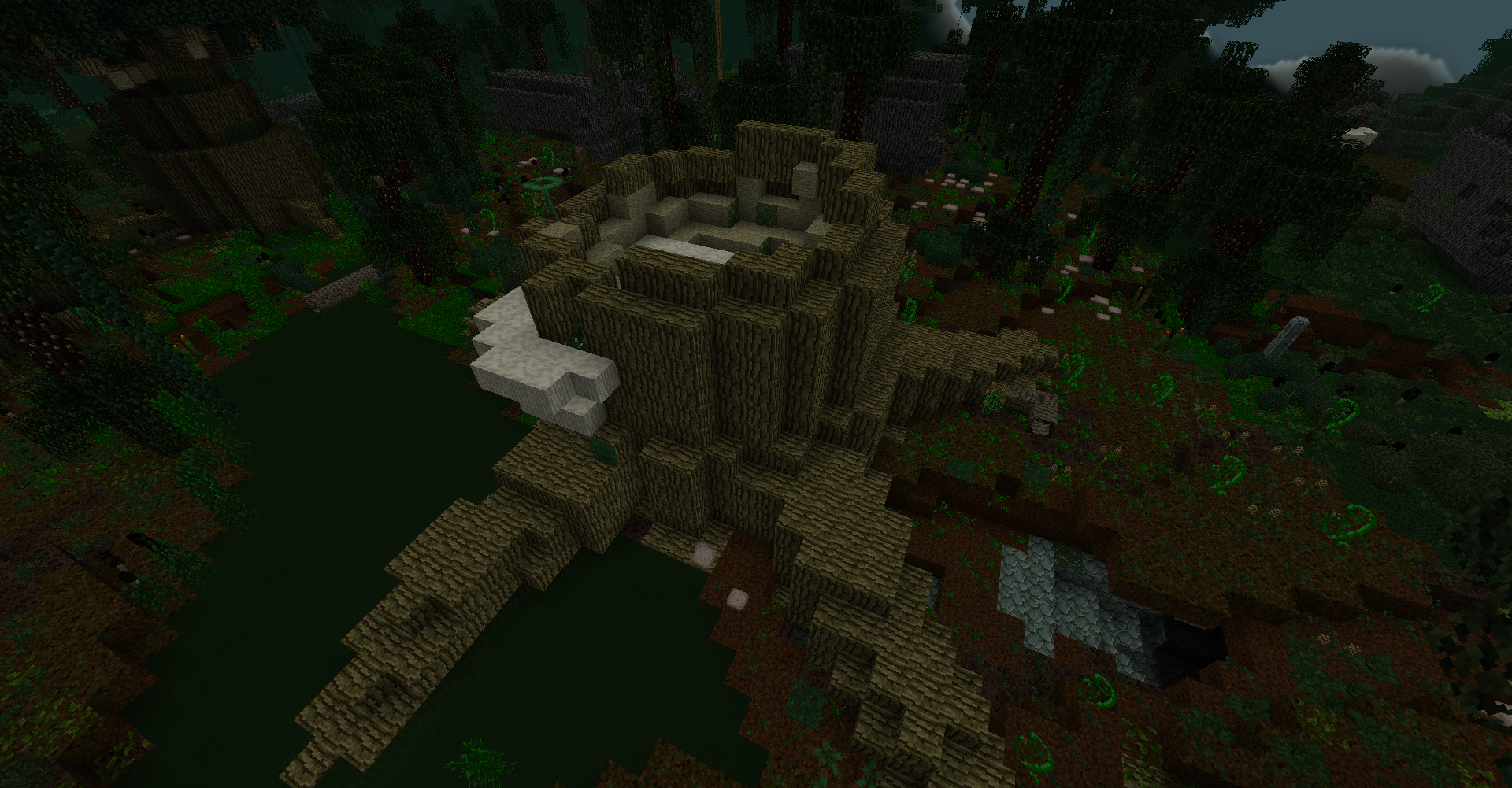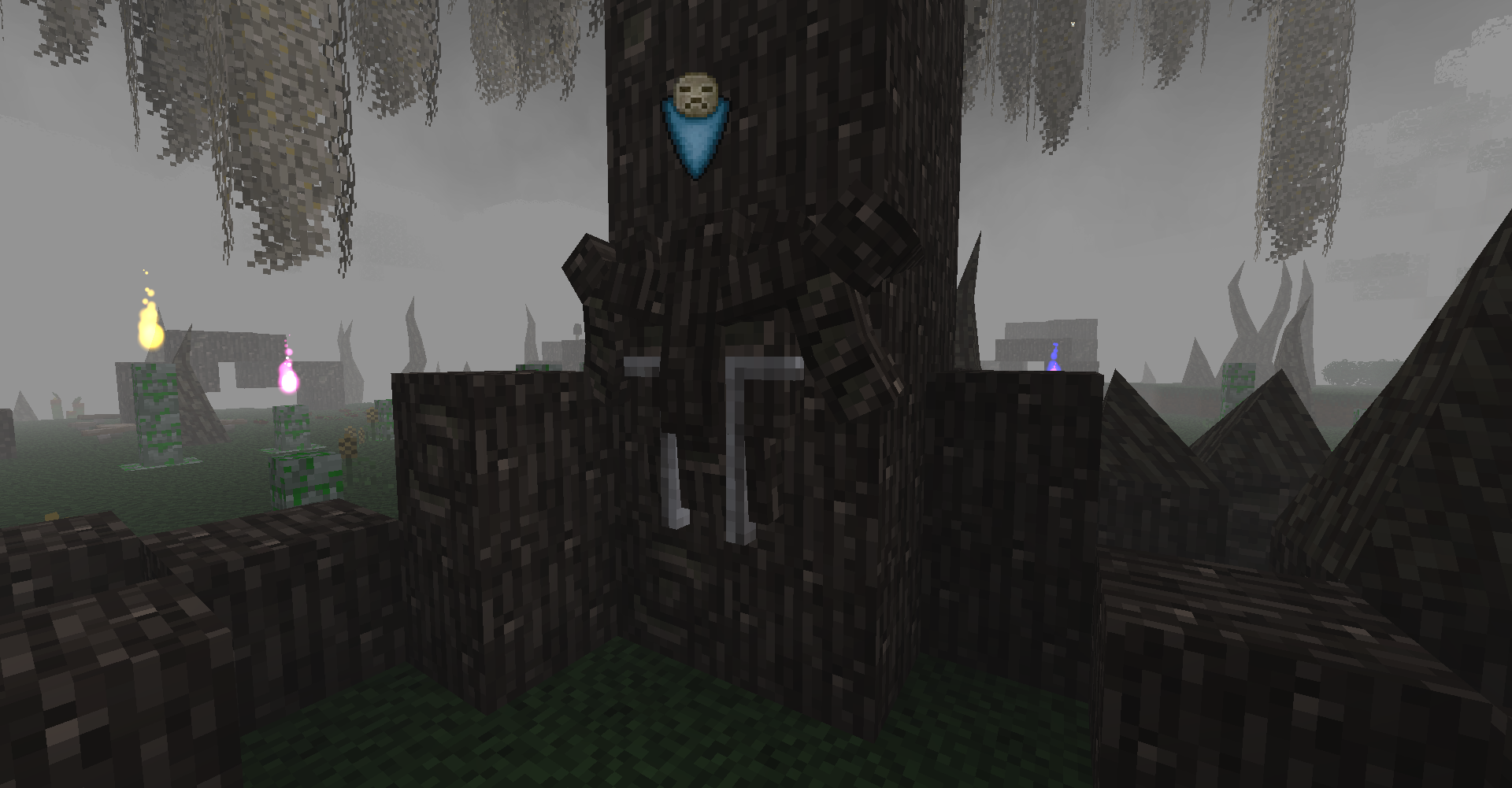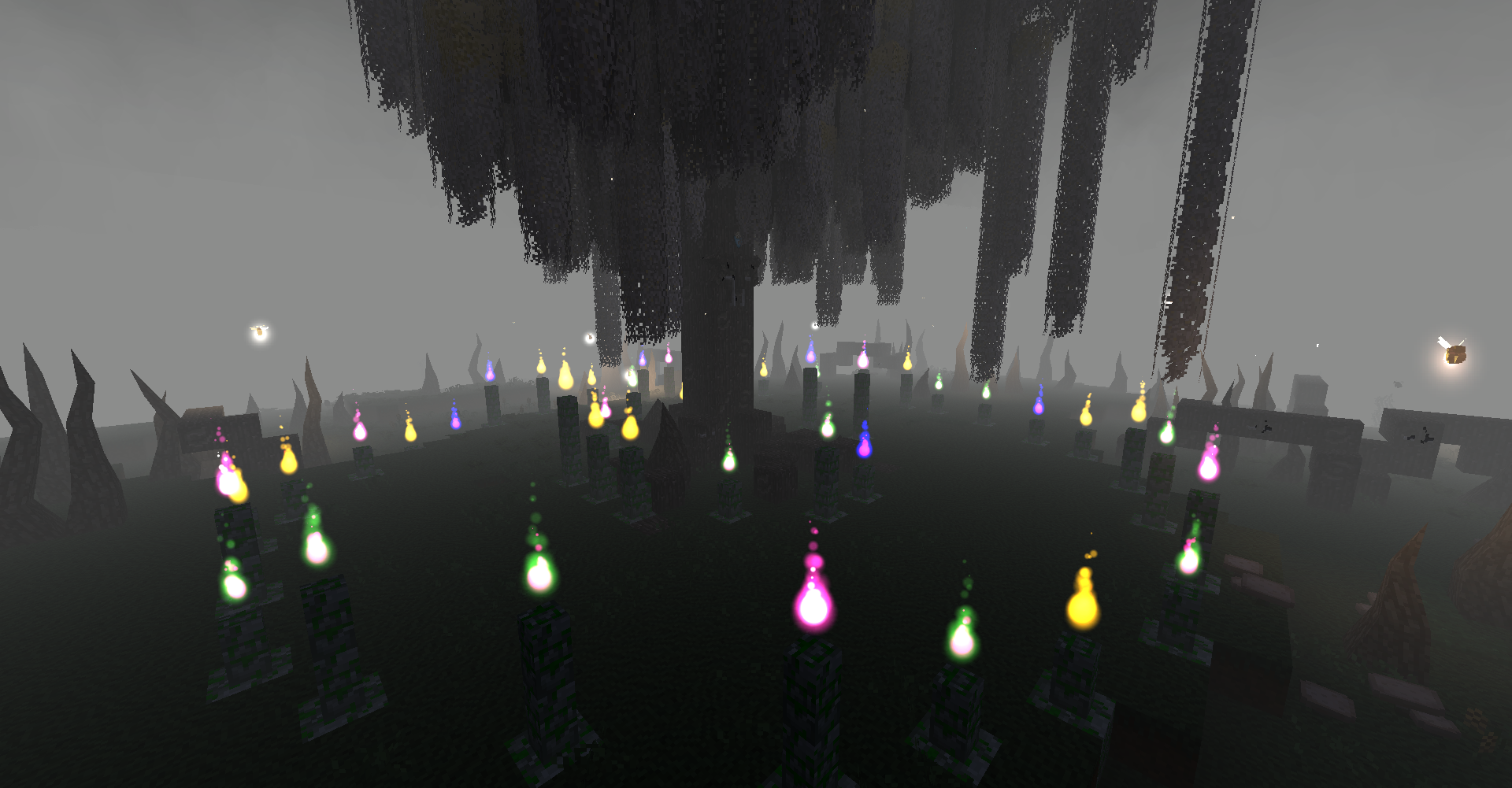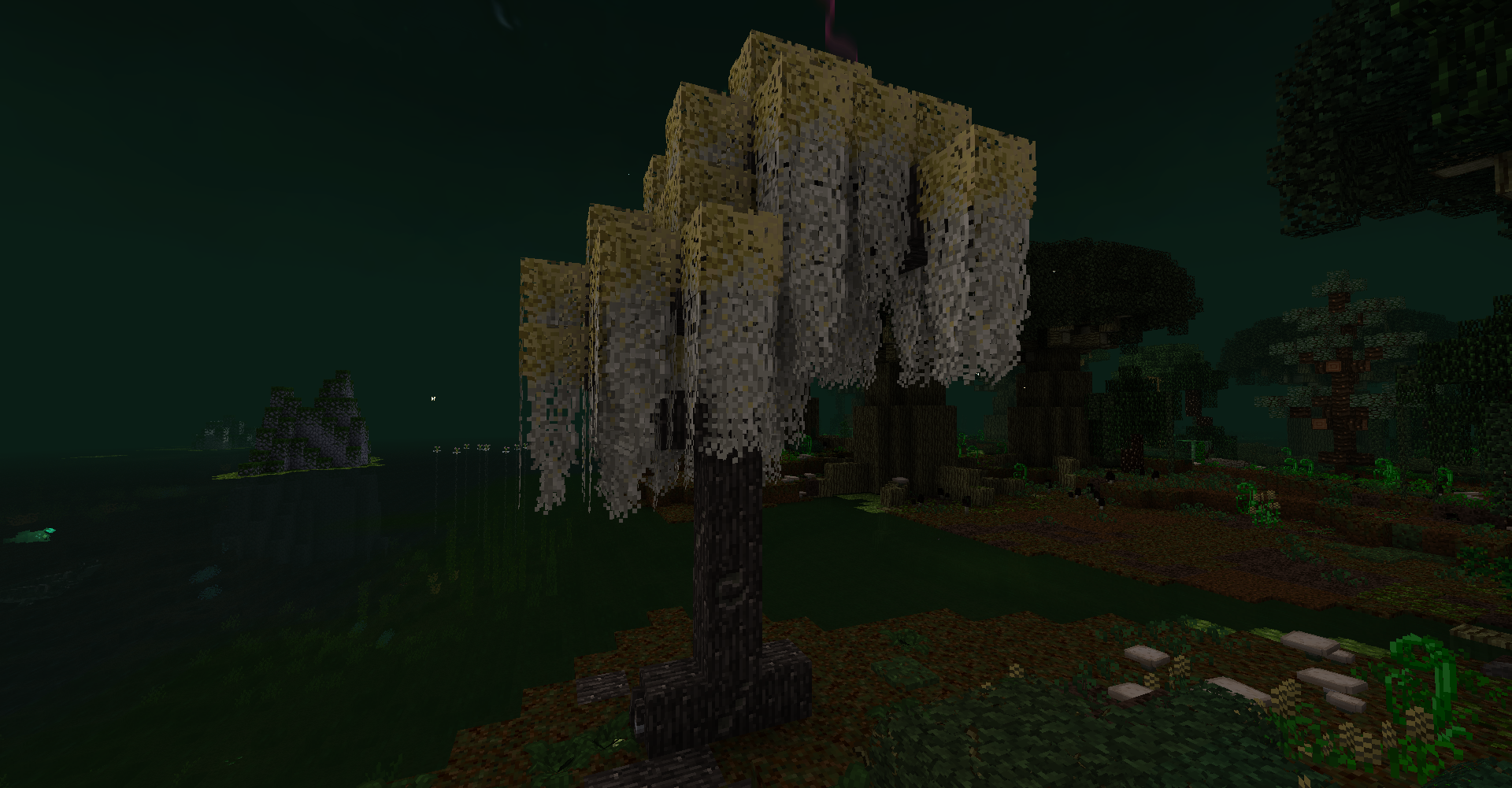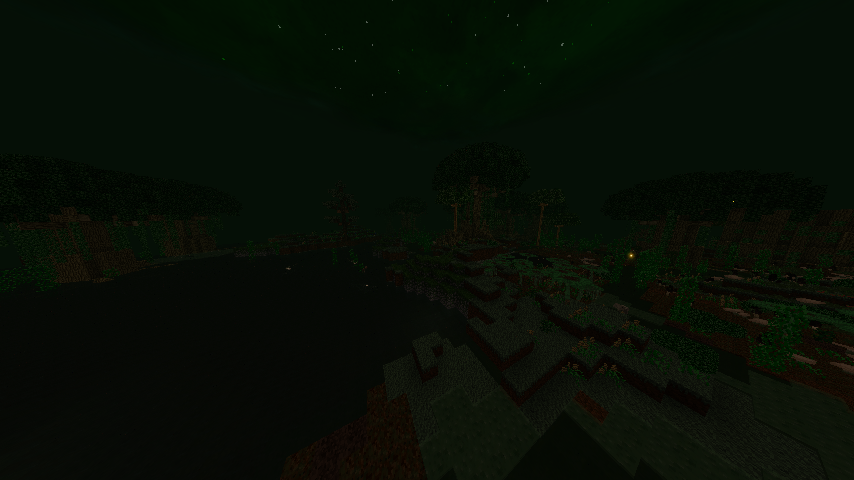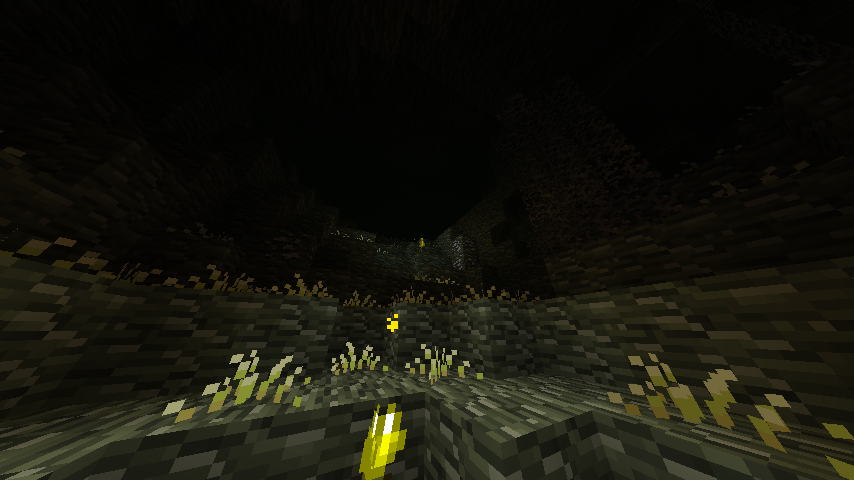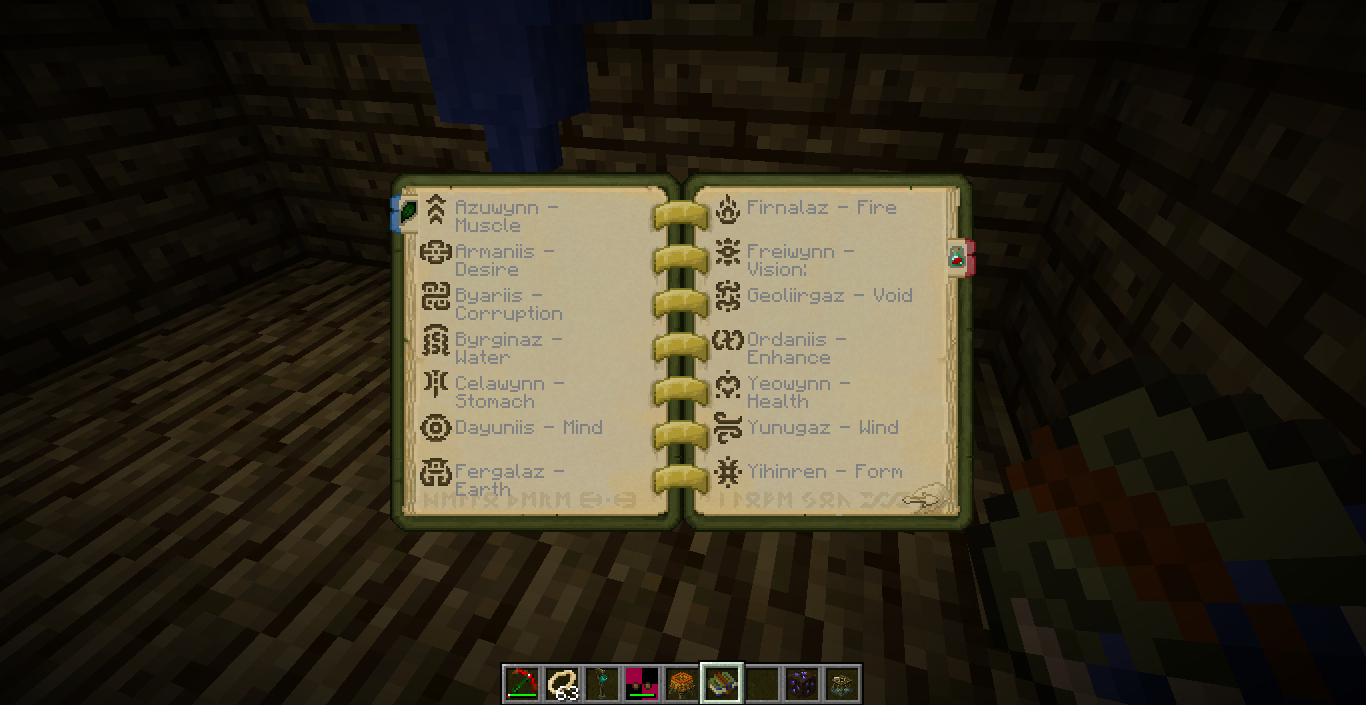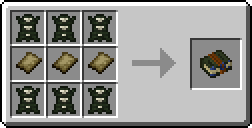ритуал леса the betweenlands
Giant Weedwood Tree
(Not to be confused with the normal Weedwood Tree or the Rotten Weedwood Tree)
Giant Weedwood Tree
Generation
A Giant Weedwood Tree in a Marsh biome
Underneath the canopy of a Giant Weedwood Tree
A Giant Weedwood Tree «stump» in a Swamplands biome
Giant Weedwood Trees are massive trees found in The Betweenlands. They generate uncommonly in Swamplands, Coarse Islands, and Marsh biomes, but cannot be grown, not even with Weedwood Saplings.
Giant Weedwood Trees have a world location that identifies the area they take up.
Contents
Description
Around 60 blocks tall and around 70 blocks wide, Giant Weedwood Trees feature a massive trunk with large supporting roots and branches. Each has multiple wide, bushy clusters of leaves that make up their sprawling canopy, drooped with Hangers. They are so large that they significantly darken the area beneath them.
In Swamplands biomes, Giant Weedwood Trees are usually cut off from the base, leaving only a large stump behind, with no leaves, Hangers, or a world location. Unlike whole trees, they are also often covered in Poison Ivy. Only whole Giant Weedwood Trees will appear with a map icon on an Amate Map.
Even moreso than regular Weedwood Trees, Giant Weedwood Trees are a great source of wood. They are also the main sources of Dentrothyst, a resource used extensively in Herblore, and the only source of Seeded Hangers, which drop White Pear Seeds used to grow White Pear plants.
Composition
Giant Weedwood Trees consist of:
Pyrads occasionally spawn on and around living Giant Weedwood Trees. Sporelings can also spawn on the Shelf Fungus found around the trunks.
Spirit Tree
Spirit Tree
Generation
The Large Face of the tree
Spirit Trees are unique boss-like trees. They feature a dense, drooping canopy, a thick trunk etched with carvings, and huge roots that jut out into the surrounding area. The trunk is surrounded by small stone pedestals, occasionally topped with Wisps.
The Spirit Tree contains multiple sentient, hostile Small Spirit Tree Face mobs, and a single Large Spirit Tree Face that acts as the primary boss.
The Spirit Tree has a world location that identifies the area it takes up, as well as a title that appear briefly to players who approach it. While in the location, the surrounding area will be covered in a light fog, and ambient sounds will fade away.
Most of the blocks of the Spirit Tree and its surroundings are protected from destruction by a ward that persists until the Large Spirit Tree Face is defeated. The tree also has varying levels of difficulty and rewards depending on the number of Wisps on the pedestals surrounding it.
Contents
Generation & Spawning
One Spirit Tree will always generate in the center of the Swamplands Clearing sub-biome. The Small Spirit Tree Faces continually spawn on the roots of the tree, while the Large Spirit Tree Face spawns on the main trunk.
Composition
Spirit Trees consist of:
Behavior
Spirit Tree Face
Health
Damage
Drops
Experience
Both Small and Large Faces take additional damage when hit with an Axe, but are unsusceptible to Lava or drowning.
Small Spirit Tree Face
Small Spirit Tree Faces act as supporting sentries, and spawn on both the main trunk and the surrounding roots of the tree. They have a couple variants with slightly different appearances. They can disappear and reappear on any side of a connected Spirit Tree Log, often doing so to reach a position where they can target the player. Their eyes and mouth glow before shooting Sap Spit projectiles at players nearby, even if they are too far away to hit. If killed, they will respawn after a while as long as the Large Spirit Tree Face remains alive.
If the block a Small Spirit Tree Face is on is somehow removed, or if it otherwise ends up in an invalid position, it will drop to the ground and attempt to teleport to a nearby Spirit Tree Log.
Large Spirit Tree Face
The Large Spirit Tree Face is the main boss, and can be found on the tree’s trunk, occasionally disappearing and reappearing on other sides of it. It has a high amount of health and uses the same Sap Spit attack as the smaller faces, on top of three additional attacks:
Effects of Wisps
A Spirit Tree with maximum Wisps
The number of Wisps on the pedestals surrounding the Spirit Tree affect the difficulty of its attacks, as well as the amount and types of loot that will be obtained upon its defeat.
This system is determined by a «wisp strength» value that starts at 1.0 with the default wisp number generated with every Spirit Tree, and fluctuates based on wisps added or removed. The change is not immediate, but rather a gradual shift over the course of the fight, so it is not possible to fight the tree at a lower wisp value and then change it to a higher value at the last moment to exploit the rewards.
The current wisp strength value is denoted visually by the glow colour of the Spirit Tree Faces.
Removing Wisps
Adding Wisps
Strategy
The Spirit Tree uses a large number of attacks that can be overwhelming at first. Ranged combat is the safest for dodging projectiles and roots, but Axes also deal considerable melee damage if the player can get close, especially an Octine Axe due to its additional fire damage. Having a Shield is also useful to block the tree’s constant projectiles.
Covering the roots surrounding the tree with blocks can also be a viable way to avoid the Small Faces’ attacks while attacking the Large Face. As the Large Face will not despawn nor regenerate health, players who find themselves unequipped for the fight can always flee and return later.
Aftermath
Upon defeating the Large Spirit Tree Face, the Tree’s block protection ward will disappear, new Small Faces will stop spawning, and the tree and the area around it will start to decay.
Several blocks of Spreading Sludgy Dirt will spawn around the Tree’s base, and several Spreading Rotten Bark blocks will replace some of the Spirit Tree Logs, appearing both in the base of the tree and on its surrounding roots. These blocks will slowly convert neighbouring Swamp Grass and Spirit Tree Logs into themselves, spreading across the Tree and the surrounding area.
As Rotten Bark spreads to the branches, the Spirit Tree Leaves will begin to break, occasionally dropping Spirit Fruit. Any of the Clearing’s ground cover plants will also turn into Dead Weedwood Bushes as their supporting grass block decays.
If left unchecked, the decay will spread until it has consumed the entire Swamplands Clearing sub-biome, essentially turning it into a miniature Sludge Plains biome that is capable of spawning Sludges and Smol Sludges. However, this can be prevented if the spreading blocks are removed or isolated quickly enough before they can expand out of control.
Once the Large Face has been defeated, the Spirit Tree’s icon on an Amate Map will be accompanied by a check mark.
Growing
The small friendly tree grown from saplings
While natural Spirit Trees cannot be grown, smaller, friendlier versions can be grown from Spirit Tree Saplings. These smaller trees consist purely of the log and leaf blocks and are inhabited by a single, friendly Small Spirit Tree Face. This Face has almost the same stats and behavior as the hostile ones, but will attack nearby hostile mobs instead of the player, albeit at a lesser range. The face can connect to Spirit Tree Logs added to its tree to extend its range, making an effective sentry. Friendly Small Spirit Tree Faces can also be fed by right-clicking them with Compost, healing them by 4 health (
Friendly Small Spirit Tree Faces can be given Amulets, giving them a Middle Gem Circle modifier that directly affects the face’s own attacks and the player they are assigned to while they are alive. The number of amulets that they can equip at once can be extended with an Amulet Slot, and amulets can be taken off of them by shift right-clicking them. (NOTE: Amulet Slot extension for this mob is intended but not yet implemented.)
Spirit Trees grown from saplings do not appear with a map icon on an Amate Map.
Drops
The drops from Small and Large Spirit Tree Faces are derived from two loot tables: spirit_tree_face_small and spirit_tree_face_large, respectively. On top of that, Spirit Fruit can also be dropped from the tree’s leaves when broken.
The following is a list of all of the items that can be dropped by Small and Large Spirit Tree Faces, including their rolls, quantities, and weights.
spirit_tree_face_small
| Small Spirit Tree Face Drops | ||
|---|---|---|
| Dropped Item | Quantity | Weight |
| 1 Roll: | ||
| Nothing | N/A | 2/3 (66.67%) |
 Sap Spit Sap Spit | 1 (+0-1 per Looting level) | 1/3 (33.33%) |
| 1 Roll: | ||
| Nothing | N/A | 8/9 (88.89%) |
 Small Spirit Tree Face Mask Small Spirit Tree Face Mask | 1 | 1/9 (11.11%) |
spirit_tree_face_large
| Large Spirit Tree Face Drops | ||
|---|---|---|
| Dropped Item | Quantity | Weight |
| 1 Roll: | ||
 Bark Amulet Bark Amulet | 1 | 1/1 (100%) |
| 1 Roll, if at 1.4 Wisp strength or higher: | ||
 Large Spirit Tree Face Mask Large Spirit Tree Face Mask | 1 | 1/1 (100%) |
| 1 Roll: | ||
 Spirit Tree Sapling Spirit Tree Sapling | 1 | 1/1 (100%) |
| 1 Roll, if at 1.2 Wisp strength or higher: | ||
| Nothing | N/A | 5/6 (83.33%) |
 Spirit Tree Sapling Spirit Tree Sapling | 1 | 1/6 (16.67%) |
| 1 Roll, if at 1.4 Wisp strength or higher: | ||
| Nothing | N/A | 4/5 (80%) |
 Spirit Tree Sapling Spirit Tree Sapling | 1 | 1/5 (20%) |
| 1 Roll, if at 1.6 Wisp strength or higher: | ||
| Nothing | N/A | 3/4 (75%) |
 Spirit Tree Sapling Spirit Tree Sapling | 1 | 1/4 (25%) |
| 1 Roll, if at 1.8 Wisp strength or higher: | ||
| Nothing | N/A | 2/3 (66.67%) |
 Spirit Tree Sapling Spirit Tree Sapling | 1 | 1/3 (33.33%) |
| 1 Roll, if at 1.95 Wisp strength or higher: | ||
| Nothing | N/A | 1/2 (50%) |
 Spirit Tree Sapling Spirit Tree Sapling | 1 | 1/2 (50%) |
Visit the Loot Tables page for more information on loot.
The Betweenlands
The Betweenlands is a dark, swampy realm crawling with strange, monstrous creatures. It is the dimension that the majority of the mod revolves around.
Contents
During the time when the light in The Overworld had just begun to shine and the flames of The Nether had just begun to burn, there existed a dimension which is little other than a void of nothingness. But out of nowhere, a giant inter-dimensional rift appeared and energy seeped into it, giving it potential for life to populate and grow in this dimension. A race of NPCs inhabited it, including a powerful Druid. He and his followers worked to twist the Nether’s evil into a weapon of peace. However, when they opened the portal in this dimension, evil surged out into it. This caused the NPCs to become Wights. The Druid himself became the Prime Wight, and he now wielded power over this dimension. He caused the Betweenlands to become a swampy, deathly land, as it is now. After much time, a traveler (the player) found their way to the dimension.
Features
The Betweenlands is so foul that Players will decay simply by living in it. The dimension has no day/night cycle of its own, although it experiences some effects from the Overworld’s day/night cycle through the periodic Rift event. Additionally, several blocks and items from the Overworld are nullified:
Tools and weapons from other dimensions are much less effective in the Betweenlands, prompting the player to use the Betweenlands tools. However, Betweenlands tools in your inventory gradually undergo Corrosion, which is a process that causes the tools to become less effective.
Players also suffer from Food Sickness when eating the same food too often, causing it to become less filling.
As Flint and Steel doesn’t work in the dimension, players need to use alternate methods to make fire. Simply hold right-click on Moss, Cave Moss, Lichen, or Thorns (either placed as a block or dropped as an item) with an Octine Ingot to light it on fire. The plant will slowly build up flame until it turns into a fire block, without consuming the ingot in the process. This is essential for getting an Infuser started.
Ground Dried Swamp Reed must be used in place of Bone Meal to fertilize plants and crops in the Betweenlands.
Players must use Moss Beds in place of normal Beds to set their spawn point in the Betweenlands. However, since there is no proper day/night cycle, players cannot sleep in Moss Beds to skip any «night», not even through the Rift event.
How to Access
The Betweenlands can be accessed by creating a Portal Tree, which contains four portals to the dimension. For more information on how to access the dimension, visit the How to get there page.
The Betweenlands’ sky
Environment
A tunnel leading into a small Limestone Cave, with Thorns growing on the side.
The Betweenlands is a dark, swamp-themed dimension.
The sky is usually an animated green patchwork of mysterious, hazy stars, although these are often covered by the dimension’s various weather Events, like Auroras, Heavy Rain, Fog, etc, along with other much more dangerous ones.
The dimension is composed of many biomes. Swamplands, Patchy Islands, Coarse Islands, Sludge Plains, Deep Waters, Marshes and even some sub-biomes. These biomes are crawling with very thick, uncontrolled flora and fauna, and many ruins of long lost civilizations, among other mysterious structures. The Betweenlands also contains several dungeons which can then be explored to get loot or to fight bosses. As the Betweenlands is still in development, it may introduce some new biomes in the future with many more structures and mobs.
The Lake Caverns, or Pitstone layer of The Betweenlands. It houses Valonite Ore, and Life Crystal Ore.
The Betweenlands features many trees and wood types. Small Weedwood Trees are often most ubiquitous, although there are also many other variations. Sap Trees, Rubber Trees, Hearthgrove Trees, Nibbletwig Trees, Hollow Logs, and Giant Roots, as well as the rare Spirit Tree boss.
Caves
Sea level in the Betweenlands is y=121, meaning caves in the dimension are much deeper. They are also very dark, with a black fog completely covering anything too far away from the player. Betweenlands caves are also split up into two layers, the upper Caverns and the lower Lake Caverns, each with different resources available. The caves themselves are often wide, interconnected, and filled with underground flora and dripping stalactites, along with echoing cave ambiance and occasional hostile mobs.
Caves are also interspersed with occasional structures you can explore.
Herblore Book
Herblore Book
Renewable
Stackable
Compostable
The inside of the Herblore Book
The Herblore Book is a special ingame manual for the Herblore system in the Betweenlands, and is necessary to discover the Aspects found on certain items.
Contents
Crafting Recipe
Navigation & Use
The Herblore Book can be opened by right-clicking, and contains pages with information about the Aspects and Infusions in the mod, with side tabs to navigate through each major part of the book. Pressing a tab will take the viewer to the corresponding part. Forward and backward arrows are present to turn the pages. Scrolling back and forth will also turn the pages, and pressing Backspace will turn to the previous page.
The first tab contains four sections: List of Aspects, List of Ingredients, Aspect Info, and Ingredient Info.
The second tab contains a list of all of the Infusions that can be created. Clicking an Infusion on the list will take the viewer to its full page, which contains its texture, a description of its effects, the Aspects required to create it, and which Aspects can be optionally added to modify it. Mentioned Aspects can be clicked to go to their corresponding pages.
Each Herblore Book stores an individual collection of Aspect discoveries based on what Gecko Cage tests were recorded in each specific book. Any number of Herblore Books can be combined through crafting to merge their discoveries together.
Pyrad
Pyrad
Health
Damage
Drops
Experience
Contents
Description
Pyrads appear as a sort of ‘nature spirit’ with glowing eyes and markings, runic plates, and a staff on its back.
When initially spawned around Giant Weedwood Trees, Pyrads are in a ‘sleeping’ state, resting on the ground, and do not attack. However, when the Rift event is not active, all Pyrads will be awake and hostile to the player. When the Rift event is active, they will not wake immediately upon being hit if dealt minor blows, but will awake after taking significant damage. They also have a chance to wake up when breaking a block from the Giant Weedwood Tree they spawned from. Note that Pyrads spawned by Monster Spawners are immediately active, regardless of the Rift status.
Once awoken, Pyrads use a leaf tornado effect similar to that granted by the Ring of Ascent to lift themselves three or four blocks off the ground, and become aggressive. When attacking, they glow (using a green shader effect) and charge their attack for a few seconds before launching three inaccurate spreads of between one and five Pyrad Flame projectiles in the target’s general direction. These fireballs are not affected by gravity, deal contact damage, and can set players, mobs and blocks on fire.
After a while, if there are no players or other targets nearby, the Pyrad will return to its sleeping state.
They have a custom death animation when killed, causing them to ‘deactivate’ and drop to the ground, sinking some into whatever ground they have come into contact with, before vanishing in a small burst of leaves.
Strategy
Pyrads can be dangerous due to their ability to shoot multiple fireballs at once, allowing them to shower a large area. Using a shield is highly recommended, as it can effectively mitigate all damage from their flames. If you don’t have a shield, try hiding behind blocks whenever they shoot to avoid the projectiles, and put out any fires you come across to minimize taken damage. This can be difficult if there are multiple Pyrads nearby, as some can shoot while others are charging. Another method may be to bring a bucket of water to put out the fire should you be set alight.
Drops
The drops from Pyrads are derived from the pyrad loot table.
The following is a list of all of the items that can be dropped by Pyrads, including their rolls, quantities, and weights.
| Pyrad Drops | ||
|---|---|---|
| Dropped Item | Quantity | Weight |
| 1 Roll: | ||
 Sulfur Sulfur | 1 (+1-3 per Looting level) | 1/1 (100%) |
| 1-3 Rolls: | ||
 Tangled Root Tangled Root | 1 (+0-2 per Looting level) | 1/1 (100%) |
| 1 Roll, if killed by player while charging attack: | ||
| Nothing | N/A | 3/4 (75%) |
 Pyrad Flame Pyrad Flame | 1-6 | 1/4 (25%) |
| 2 Rolls, if killed by player, Spook event only: | ||
| Nothing | N/A | 3/6 (50%) |
 Blue Candy Blue Candy | 1 | 1/6 (16.67%) |
 Red Candy Red Candy | 1 | 1/6 (16.67%) |
 Yellow Candy Yellow Candy | 1 | 1/6 (16.67%) |
| 1 Roll, if killed by player, Winter event only: | ||
| Nothing | N/A | 1/2 (50%) |
 Mince Pie Mince Pie | 1 | 1/2 (50%) |
Visit the Loot Tables page for more information on loot.
